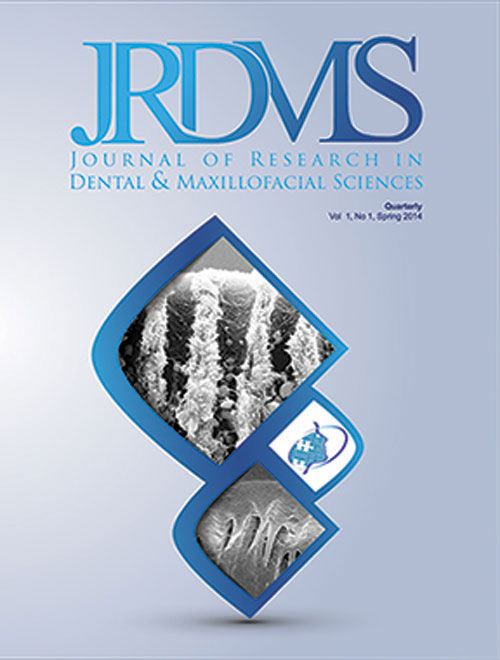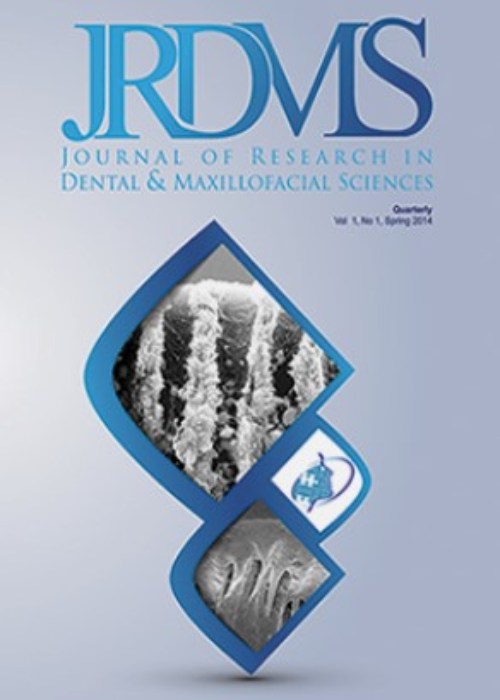فهرست مطالب

Journal of Research in Dental and Maxillofacial Sciences
Volume:5 Issue: 2, Spring 2020
- تاریخ انتشار: 1399/04/11
- تعداد عناوین: 7
-
-
Page 1
On 20 January 2020, the World Health Organization (WHO) stated that the outbreak of Coronavirus disease 2019 (COVID-19) is a global concern that poses a high risk for countries like Iran with vulnerable health systems. In Iran, virtual education began a few weeks after the suspension of universities. However, this was difficult for the field of dentistry to achieve as practical courses cover most of the academic semester. In this article, we state the problems among dental schools of Iran during the outbreak of COVID-19.
Keywords: COVID-19, Dental Education, Humans -
Pages 2-6Background and Aim
This study aimed to compare the level of pain, wound healing, facial edema, and surgeon’s comfort in surgical extraction of impacted third molars using surgical scalpel versus radiofrequency (RF) incision.
Materials and MethodsThis split-mouth clinical trial evaluated 41 patients with bilateral impacted third molars in one jaw with the same Pederson difficulty index (between 5 and 7, moderate difficulty). The surgical incision was made using a surgical scalpel on one random side and an RF device on the contralateral side. The level of pain was measured using a numerical rating scale (NRS) 7 days postoperatively. The wound healing was evaluated using the wound evaluation scale (WES) 4 weeks postoperatively. Facial edema was quantified using a tape measure 7 days postoperatively. Surgeon’s comfort was assessed by asking the surgeons regarding the level of easiness of the procedure. The pain score, wound healing score, facial edema, and surgeon’s comfort in surgical extraction of impacted third molars were compared between the two sides using SPSS 22 via paired t-test and McNemar’s test.
ResultsThe surgeon’s comfort was significantly higher in the use of a surgical scalpel (P<0.001). The difference in pain score (P=0.95), wound healing (P=0.32), and facial edema (P>0.05) was not significant between the two groups.
ConclusionThe results of this study showed no significant difference in surgical extraction of impacted third molars using a surgical scalpel or an RF device regarding the level of pain, wound healing, or facial edema.
Keywords: Pain, Wound Healing, Edema, Impacted Tooth, Third Molar, Tooth Extraction, Radiofrequency Therapy -
Pages 7-13Background and Aim
Diode laser is a great choice for soft tissue surgery. The diode laser is partially absorbed by hard dental tissues, making it safe for soft tissue surgery. This study aimed to compare the tissue thermal changes induced by three types of diode lasers at 810, 940, and 980nm wavelengths.
Materials and MethodsIn this in-vitro experimental study, using a diode laser device (continuous mode with a 400μm fiber tip) at each of the 810, 940, and 980nm wavelengths and powers of 1, 2, and 3W in contact mode, incisions with the length of 2cm were made on pieces of meat over a period of 10 seconds. The primary and secondary temperatures were measured using a thermocouple. Data were analyzed using two-way analysis of variance (ANOVA).
ResultsTissue temperature changes induced by diode laser at 810nm/3W were significantly greater than that of 2W power. These changes were higher with 2W of power compared to 1W (P<0.05). Temperature changes induced by diode laser at 940nm/2 and 3W were significantly greater than that of 1W power (P<0.05). Temperature changes induced by diode laser at 980nm/3W were significantly greater than that of 2W power. Tissue temperature changes were higher with 2W of power compared to 1W (P<0.05).
ConclusionDiode laser (continuous mode with a 400µm fiber tip) at 3W of power and 980nm wavelength caused the highest rate of thermal changes. The 810nm diode laser with the power of 1W caused the slightest heat changes in the soft tissue.
Keywords: Diode Laser, Temperature, Soft Tissue Injuries -
Pages 14-20Background and Aim
Different methods have been proposed for rapid disinfection of gutta-percha (GP) cones. This study aimed to assess the efficacy of low-pressure radiofrequency cold plasma (LRFCP) in disinfection of GP cones compared to three chemical disinfectants.
Materials and MethodsSeventy GP cones were allocated to seven groups of 10 each. All samples were initially sterilized with ethylene oxide (EO) and subsequently inoculated with Staphylococcus aureus (S. aureus), except for the negative control group (n=10). In the experimental groups (n=50), samples were subjected to one-minute chemical disinfection [5.25% sodium hypochlorite (NaOCl), 2% chlorhexidine (CHX), and 10% Deconex® 53 PLUS) or LRFCP (30-second or one-minute). The effectiveness of disinfection was evaluated by counting the colony-forming units (CFUs). Data were analyzed using Kruskal-Wallis test (P=0.05).
ResultsS. aureus was completely eradicated in all groups. LRFCP and 5.25% NaOCl were the most effective agents in disinfection of GP cones. In addition, 2% CHX was significantly weaker than the other agents (P<0.05). Deconex® 53 PLUS (10%) was more potent than 2% CHX; however, the difference between 10% Deconex® 53 PLUS and other experimental groups was not significant (P>0.05).
ConclusionLRFCP can be assumed as a noninvasive and efficient method for disinfection of GP cones.
Keywords: Disinfection, Gutta-Percha, Cold Plasma, Staphylococcus aureus -
Pages 21-25Background and Aim
One of the most important problems with composite restorations is the loss of consistency between the composite and tooth color. The present study aimed to compare the color stability of two types of nanohybrid composites cured with different light-curing devices after aging.
Materials and MethodsIn this study, the color stability of 40 disc-shaped specimens (10 mm in diameter and 2 mm in height) from two types of enamel and dentin nanohybrid composites (IPS Empress Direct, Ivoclar Vivadent) was investigated. A group of 10 samples of each composite was cured by light-emitting diode (LED) Bluephase device (Ivoclar, Vivadent) at 1200 mW/cm2 for 20 seconds, and another group of 10 specimens was cured by a quartz-tungsten-halogen (QTH) device (Coltolux 2.5, Colten, USA) at 600 mW/cm2 for 40 seconds. The initial color of the samples was determined by the Konica Minolta spectrophotometer (CS2000, USA), and then, the composite samples were subjected to an accelerated artificial aging (AAA) process in the QUV/SPRAY device. Then, the color of the samples was reassessed. Two-way analysis of variance (ANOVA) was used to compare the color changes in the study groups at a significance level of P=0.05.
ResultsThe specimens cured by the LED device showed significantly lower color change compared to QTH (P=0.047). However, there was no significant difference in color stability between enamel and dentin composites cured by a fixed apparatus (P=0.474).
ConclusionThe curing of nanohybrid composites with LED devices causes lower color change compared to QTH.
Keywords: Aging, Composite Resins, Dental Curing Light, Spectrophotometry -
Pages 26-33Background and Aim
Autogenous bone grafts are considered the gold standard although they have several disadvantages, leading to a search for suitable alternative graft biomaterials. This study evaluates the histological and histomorphometric properties of regenerated bone in defects in rabbits following the application of two commercially available xenografts (Bio-Oss and Osteon).
Materials and MethodsThis animal study was carried out on 14 New Zealand rabbit calvaria. Four 6.5-mm critical-size defect (CSD) models of bone regeneration were formed in each surgical site. The first defect was filled with Bio-Oss, the second with large Osteon (L-Osteon), the third with small Osteon (S-Osteon), and the last one remained unfilled (the control group). The cases were sacrificed. Bone forming properties (amount of new bone formation, inflammation, and foreign body reaction) were observed at 4- and 8-week intervals through histological and histomorphometric examinations. The Friedman test, Kruskal-Wallis test, and Wilcoxon test for multiple comparisons were used for data analysis. The level of statistical significance was set at 0.05.
ResultsThere was no statistically significant difference for regenerated bone among the four groups (P>0.05). The L-Osteon site showed more inflammation and foreign body reaction compared to the other groups.
ConclusionThe results of this study showed that Bio-Oss and Osteon appear to be highly biocompatible and osteoconductive and can thus successfully be used as bone substitutes in augmentation procedures.
Keywords: Biocompatible Materials, Bio-Oss, Bone Grafting, Bone Formation, Bone Substitutes, Histology, Osteon -
Pages 34-38Background
Radicular cysts are the most frequent odontogenic cysts of the jaws. Radicular cysts arising from the primary teeth are very rare and comprise 0.5% to 3.3% of radicular cysts in both primary and permanent dentitions.
Case PresentationIn this paper, we report the clinical, radiographical, and histological characteristics of a radicular cyst associated with a maxillary deciduous first molar. The treatment plan included extraction and enucleation of the cyst under local anesthesia after the elevation of a mucoperiosteal flap, which led to satisfactory and uneventful healing.
ConclusionEarly diagnosis of radicular cysts associated with the primary dentition allows for a less aggressive treatment plan and prevents adverse effects on the permanent successor.
Keywords: Radicular Cyst, Primary Molar, Deciduous, Periapical Cyst


